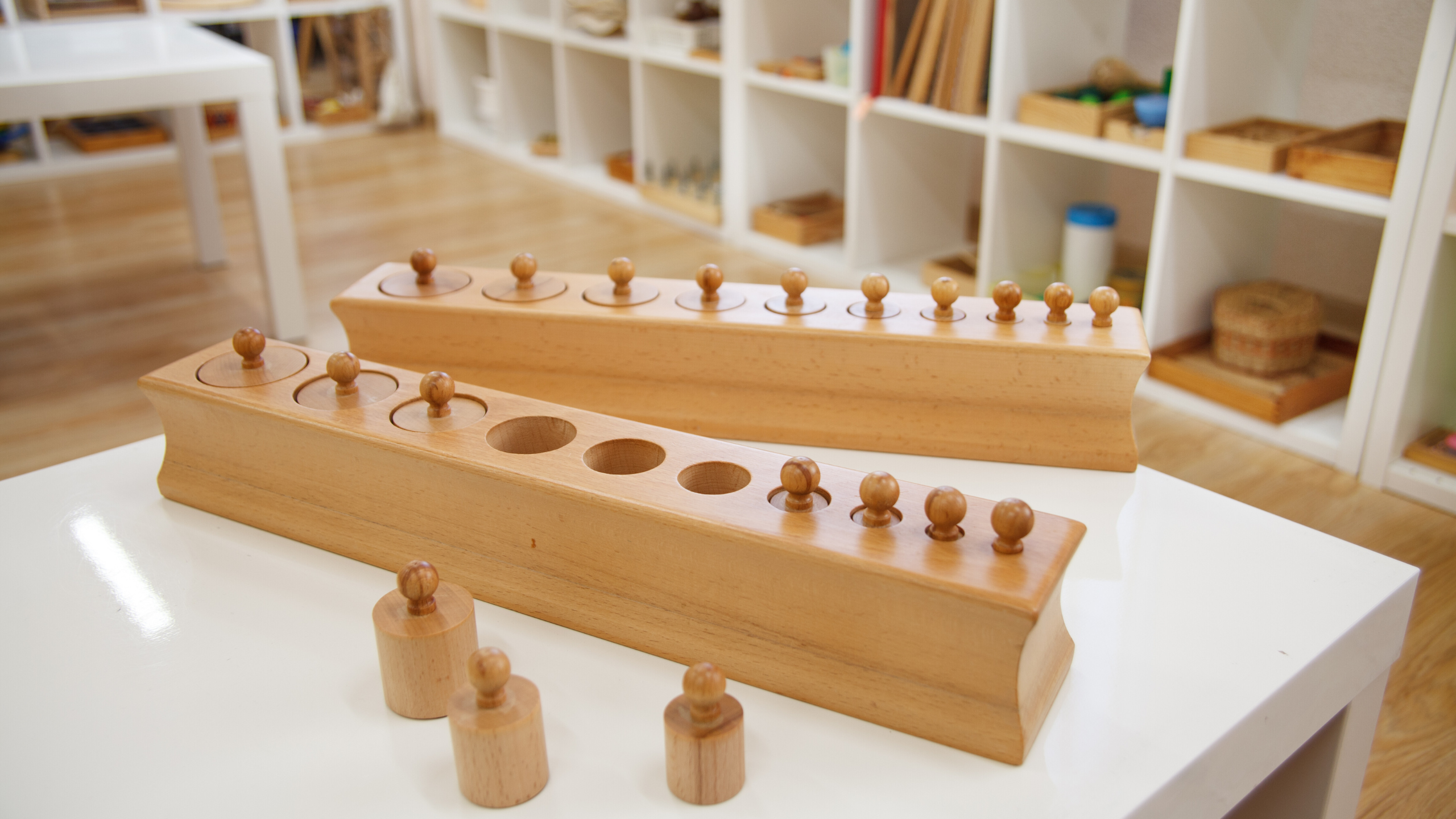Control of Error and Montessori Materials

Have you ever watched what happens when an adult corrects a child? You can’t help but see the sadness and sense of defeat in their eyes. This type of correction can negatively impact a child’s self-esteem and their willingness to try new things or to challenge themselves. For this reason and many others, Dr. Maria Montessori developed materials with built-in control of error, allowing the child to discover their mistakes and self-correct.
What is control of error?
According to the American Montessori Society (AMS), control of error describes the fact that “Montessori materials are designed so that the child receives instant feedback about [their] progress as [they work], allowing [them] to recognize, correct, and learn from an error without adult assistance.” Providing the child with this type of control not only aids in their learning, but also fosters their self-esteem and self-motivation. As a child discovers their own error and is able to work to correct their mistake, they not only strengthen their confidence, they also learn to analyze and solve problems and develop a sense of pride in their dedication and diligence that is intrinsically rewarding and motivating.
What does control of error look like in Montessori materials?
The materials Dr. Montessori developed each have a specific control of error, allowing the child to discover and correct their mistakes without the need of adult assistance. The Knobbed Cylinders provide a great example of this concept. Each cylinder fits precisely in its designated space. The child is able to use trial and error to find the hole in which each cylinder perfectly fits; if they happen to place a cylinder into the wrong hole, they will be able to self-correct when they realize they have a remaining cylinder that does not fit in the hole that is open. Dr. Montessori illustrated this concept wonderfully as she stated:
By exercising control of error when working with the apparatus, the child’s mind is held by the apparatus. If he replaces the cylinders incorrectly and there is one cylinder left without a cavity he will be inclined to wonder why there is still one cylinder left. Why? Although he does not reason exactly as we would, he realizes it subconsciously through his actions.
Maria Montessori, The 1946 London Lectures, p.82.
For language materials, such as the common three-part cards, control of error can be found in an added piece of the work. Three-part cards typically include a card with an image or photograph, a card with a written key term, and a control card. The control card is a larger card containing the key term and the image or photograph together. The child can place this card next to the key term and image or photograph they have matched to check their work.
For math exercises, like the Cards and Counters work, the control of error is the number of manipulatives. There should be precisely enough counters to represent the numerals shown. If the child does not have enough counters or has counters remaining when they have completed the work, they will be able to recognize they have made a mistake and can go back to review their work and correct their error.
Control of error even exists in Montessori Practical Life activities. For instance, if a child were learning to pour their own water or juice, the control of error is that the liquid must be poured into the glass. If it is not, it spills and there is no water or juice to drink. In this situation, the child learns that the mess can be cleaned up and they can try again. This process also helps the child to understand that mistakes happen and can be corrected with a little patience and diligence.
Benefits of control of error
Control of error wields many benefits for children.
- Boosts confidence - Correction from others has a damaging effect on one’s self-esteem. When a child is able to identify their mistakes and rectify them without criticism, judgment, or embarrassment, they develop a sense of confidence.
- Develops critical thinking and problem solving abilities - Control of error provides the child with an opportunity to identify that a mistake has been made and to then think critically to find a solution to the problem.
- Promotes independence - Since adult assistance is not needed in order to complete the work successfully, a child develops a sense of independence, learning that they are capable of accomplishing things without relying on someone else for help.
- Fosters perseverance - The process of making a mistake, correcting the mistake, and then successfully accomplishing a task or goal helps the child understand that hard work is rewarding. This will help provide them with confidence and reassurance the next time they are faced with a challenge.
- Discourages fear of failure - As children are given the freedom to make mistakes and learn to correct those mistakes, they also learn that it is ok not always have the answer or do things right the first time. They learn to focus less on their mistakes and more on how to find a solution.
- Delivers intrinsic reward - When a child makes a mistake and then works hard to find a solution and is able to successfully accomplish a task, they feel good inside. This pride and joy motivates them and encourages them to continue trying, reassuring them of their ability.
- Allows for auto-education - One of the key principles of the Montessori Method is auto-education. Auto-education is the idea that given the correct environment and the nurturing guidance of a teacher or parent, children will educate themselves. Control of error allows children to discover their mistakes, problem solve, and complete works independently, thus teaching themselves along the way without the need for direct instruction from an adult.
“Let us always remember that inner discipline is something to come, and not something already present. Our task is to show the way to discipline. Discipline is born when the child concentrates his attention on some object that attracts him and which provides him not only with a useful exercise but with a control of error. Thanks to these exercises, a wonderful integration takes place in the infant soul, as a result of which the child becomes calm, radiantly happy, busy, forgetful of himself and, in consequence, in difference to prizes or material, rewards. These little conquerors of themselves and of the world about them are real supermen, who show us the divine worth of man’s soul.”
Maria Montessori, The Absorbent Mind, p.240
